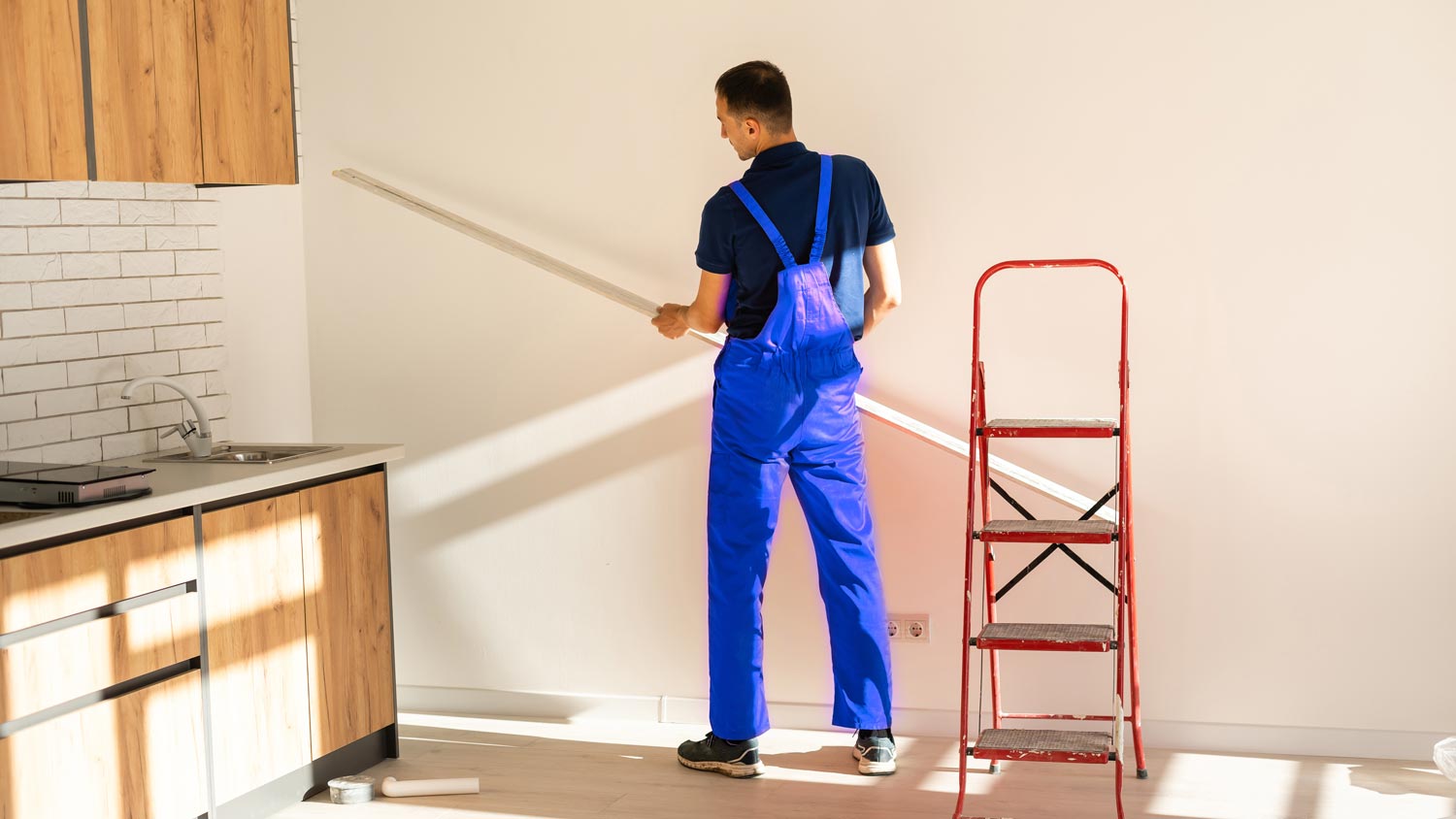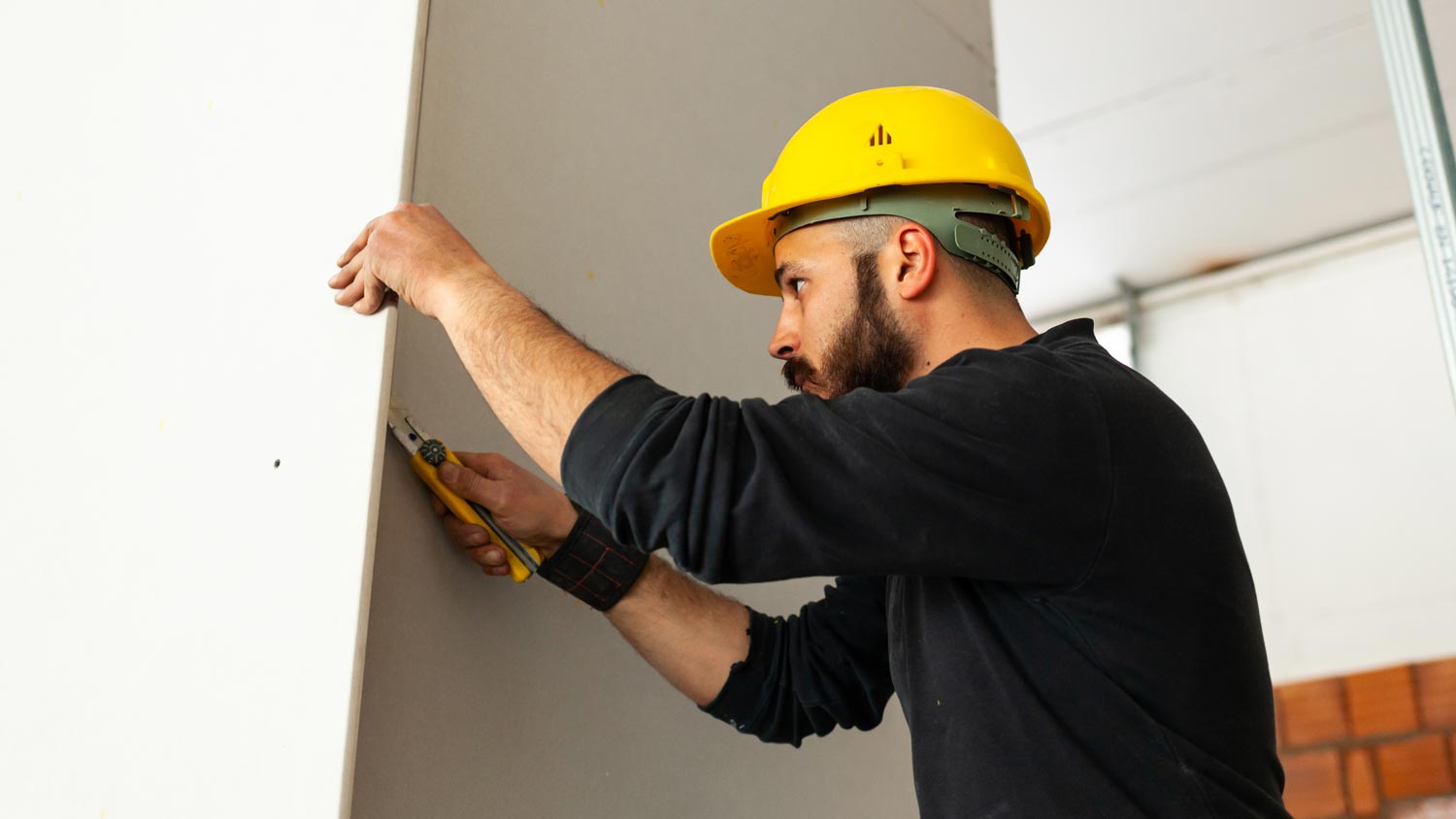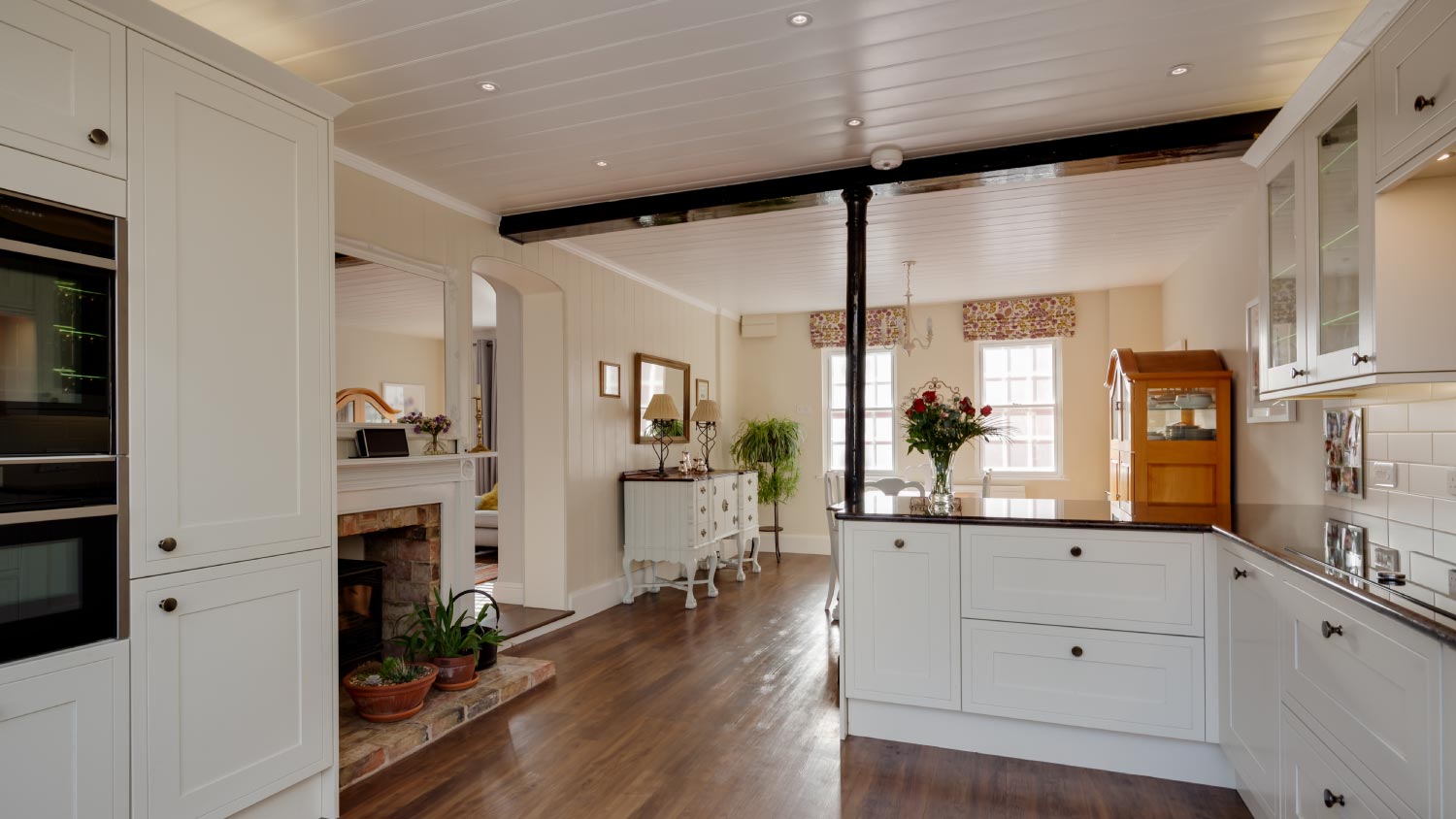How to Cut Drywall Before and After Hanging It
Use the right tools to get clean and professional cuts on your drywall


Drywall is as versatile as it is quick to install. Whether you’re building a new addition, adding a wall, creating an archway, or patching holes in a wall, drywall is a simple and affordable building material to get the job done. However, the product comes in large 4-by-8-foot sheets that you must cut to fit. In this guide, we explain how to cut drywall quickly and easily using a variety of tools for different applications.
Preparing to Cut Drywall
Drywall is available in lengths up to 12 feet long, so you’ll need a good amount of space to work in and maneuver the material when cutting. Aside from having plenty of room to work, take some safety precautions. Cutting drywall produces airborne crystalline silica, which can be harmful if inhaled.
Crystalline silica is a toxic dust that's often generated during drywall installation, which can cause respiratory issues if exposed over time. A professional drywall installation company has the right tools to protect your home and ensure safe air quality after your project is completed.
How to Measure and Mark Drywall

The first step to successful drywall cutting is accurate measuring. Measure the wall space that the drywall sheet will cover. Note the measurements for height and width. Also, measure the locations of doors, windows, and electrical outlets that will fall within the sheet’s space. Measuring twice before making any cuts is a good idea to avoid mistakes.
For lengthwise cuts, make one mark along the long edge of the sheet. Make the mark approximately ⅛ inch shorter than the actual measurement. This will leave some wiggle room for mistakes and expansion, and you can fill the gap later with drywall mud. Line the drywall T square up to the mark and continue a line from edge to edge of the sheet.
For height cuts or cuts that cross the long dimension of the drywall, make a mark on each short edge of the sheet, about 1/8 inch less than you need. Use a chalk line to connect the two marks. If you have a long enough straight edge, you can use that instead.
At windows, doors, and outlets, mark and draw the outline of each item. Leave 1/8 inch of clearance on each edge that you draw. Use the T square or another straight edge to make precise lines. Depending on the tools you have, you can mark the approximate location of cutouts, hang the drywall, and cut out the piece in place. More on this later.
How to Score Drywall With a Utility Knife

The most straightforward cut to make in drywall—a straight line from one end of the sheet to the other—is also the most common. Use a utility knife when cutting a continuous straight line from one side to another in the drywall.
“As with any custom cutting, we stick to the adage of ‘measure twice, cut once,’” says Bob Tschudi, Angi Expert Review Board member and general contractor in Raleigh, NC. “For drywall, we also make sure that the razor blades are always sharp, as a dull blade will tear the paper.”
Lay the marked drywall flat on the floor or lean it against a wall. Score the top paper of the sheet by firmly dragging the utility knife along the entire length of your line. Use the T square to get a perfectly straight score.
Turn the sheet over so that the back of the sheet is facing upward. If you have it leaned against a wall, turn the sheet around so the back is facing you. Grasp the edge of the sheet section you’re removing with one hand. Press firmly at the cut location with the other hand. Pull the sheet part you’re removing upward (or toward you if leaning) until the gypsum snaps apart.
Continue to support the cut piece and cut the backing paper along the broken seam with your utility knife. Cut from end to end and remove the cut piece. You can use the drywall rasp to cut down rough areas of the cut.
How to Cut Drywall With a Saw

Drywall is relatively easy to cut, so you can use just about any saw for a clean cut. There are a few recommended saws, though, which bring different things to the table:
Jab saw: A jab saw is a manual tool, so it’s affordable and relatively safe to use. It has a sharp point and teeth along the long blade, so it’s ideal for puncturing drywall and cutting cutouts for electrical boxes. Jab saw cuts can be messy, so it’s not a good tool for long, straight cuts.
Spiral saw: A spiral saw is like an electric jab saw. It uses a bit that can sink directly into the drywall and then cut laterally once it’s through. A spiral saw is perfect for small, intricate cutouts, like outlets, switches, and light fixtures.
Oscillating multi-tool: An oscillating multi-tool is ideal for making small, precise cuts that are straight, although you could use it for longer straight cuts, too. You can get different attachments, including one in the exact shape of an electrical box for the easiest cutting possible. These tools are sometimes referred to as drywall routers, as you can fit them with cutoff router bits for easy electrical box cutting.
Hole saw: A hole saw is a bit that attaches to an electric drill, and it has blades situated in a perfect circle to make circular cuts in drywall. This is a great tool for cutting out holes for light fixtures.
Reciprocating saw: A reciprocating saw is a bit overpowered for cutting drywall, but you can make it work for cutting out electrical boxes or curves. You’ll need to drill through the drywall and insert the blade into the hole before cutting.
Cutting Drywall Before Hanging It
The skill you’ll use most often when cutting drywall is making cuts before installing the sheet. To do this, stand the drywall sheet on its edge or elevate it to create open space below. Use your preferred saw to make your cut. If you’re making long cuts from edge to edge, use your T square for a clean, straight line.
You can also cut out holes for electrical boxes or plumbing lines before hanging your drywall. If you go this route, measure twice and check your marks before making cuts. Mistakes can be costly, either in drywall repairs after your new walls are up or in buying new sheets to make your corrections.
Remember, you also have the option to make your large cuts off the wall and then make cutouts after you hang the drywall. Just be sure you mark the cutouts beforehand.
Cutting Drywall After Hanging It
As your drywall cutting skills improve, you can save time and create more accurate cuts by making them after the drywall is in place. In most cases, you’ll only perform cutouts after hanging, and you should complete any long, straight cuts to fit the piece in place before you hang the sheet. You can make cuts after hanging using a jab saw, oscillating saw, or drywall router and spiral saw.
First, turn off the power to the electrical circuit if you’re cutting outlet holes in the drywall. Even if you believe the power is off, using a contactless circuit tester to double-check is a good idea. Install the drywall sheet in its final location, making sure you mark the center of the electrical box on the outside surface of your drywall. Use several screws to attach it to the wall, but only enough screws for support.
Poke your saw through the drywall and into the box. Cut slowly toward the edge until you find it, then cut along the outside edge of the outlet box, window frame, or door frame until you reach the end of the first edge. Turn your saw blade in the direction of the next edge and continue cutting. Continue until the cut piece is detached, then finish attaching the drywall sheet to the wall with drywall screws.
“If your cutouts for outlets are slightly larger than the wall plate, you might not have to repair it, as electrical suppliers now offer oversized covers,” says Tschudi. “We use these ‘jumbo’ covers as our standard.”
Making Combination Cuts
Many times, you’ll encounter two perpendicular cut lines that intersect. Use a combination of techniques to make the cuts.
Cut the shortest lines of the layout dimensions from one edge of the sheet to the intersection with a jab saw, oscillating multi-tool, or spiral saw, as in step three. You can also use a reciprocating saw if you’re cutting inward from the edge of the sheet. After making the short cuts, cut the long line with your utility knife and snap the sheet, as in step two. Use the rasp to clean up any rough edges.
Safety Tips When Handling and Cutting Drywall
To help avoid health issues, make sure you follow the safety tips below any time you’re cutting or installing drywall:
Always wear a respirator to protect your lungs. Don’t settle for a dust mask, as small drywall particles can still make it through the material.
Opt for safety goggles rather than glasses. A good seal against your face will help avoid eye irritation from airborne dust.
Know where your electrical and plumbing lines run before cutting into a wall. When in doubt, shut the electricity off and cut slowly to avoid damaging lines.
Sweep up dust regularly between cuts, as the small particles can make floors slippery.
Invest in the right tools for your needs. We recommend at least a utility knife, a jab saw, and a straight edge. Power tools are a great addition for speeding things up but require additional safety precautions.
DIY vs. Hiring a Pro
Cutting drywall is a simple process, but it can be challenging to accurately measure the location of outlets and other cutouts. Fortunately, drywall mud can cover almost any mistake, so you won’t have to throw away less-than-perfect sheets. Still, the process can prove frustrating, especially if you’re working with the bare minimum as far as tools for drywall go.
If hanging drywall isn’t your idea of a good time, or if you don’t have the time for a large project, a local drywall installer can help. Professional drywall installation costs around $1.50 to $3 per square foot, which includes cutting, hanging, and finishing for the entire project.
If you don’t have the experience or patience to get the job done yourself in a way that still looks professional, we recommend hiring a pro. The service can get pricey, but you’re more likely to end up with a finished product you’ll love for years to come.
The best way to make long, straight cuts is to use a utility knife and a T-square to score the sheet, snap along the score, and then finish the cut by cutting through the paper on the opposite side with the utility knife. If you’re making small cuts, curved cuts, or cutouts for electrical boxes or light fixtures, you can use a manual jab saw to keep costs down, but an electric spiral saw or oscillating multi-tool will get the cleanest, fastest cuts possible.
The easiest way to cut holes in drywall for electrical boxes is to use a spiral saw with a drywall router bit. Hang the drywall without cutting out a hole for the box, but make sure you measure and mark where the box is located on the wall. Once you screw in the drywall sheet, drill a small hole into the box void, insert the spiral saw bit, and move it around the edge of the box using the inside wall as a guide. You can also use an oscillating multi-tool with an electrical box cutout for fast, professional results.
There is no way to cut drywall without making dust, but you can reduce the amount of dust and especially the dangerous airborne particles by using manual cutting tools. Using a utility knife to score and snap your drywall will minimize dust production, and a jab saw for cutting cutouts for boxes and fixtures will generate almost no airborne dust. Even if you use these methods, you should still wear a respirator and safety goggles to avoid damage to your lungs and eyes.

















